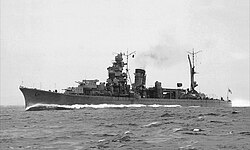Noshiro (ship, 1943)
|
||||||||||||||||||
|
||||||||||||||||||
|
||||||||||||||||||
|
||||||||||||||||||
The Noshiro ( Japanese 能 代 ) was a light cruiser of the Japanese Navy that was used in World War II . The ship belonged to the Agano class and was sunk by American planes during the sea and air battle in the Gulf of Leyte on October 26, 1944.
Conversions
The Noshiro received a few modifications between January and March 1944. The 13mm L / 72 machine guns were removed and replaced with 25mm L / 60 Type 96 guns. The anti-aircraft defense system was also increased with eight individual 25 mm automatic cannons. The cruiser was equipped with an infrared communication system.
In early July 1944, the ship received another 25 mm L / 60 automatic cannons type 96. Two triplets and ten single mounts were added. The ship now carried all three of the Navy's standard radar systems , the Type 21 radar for surface searches, the Type 22 for fire control and the Type 13 for air searches.
Calls
The Noshiro was after her commissioning in late August 1943, flagship of the second destroyer flotilla. On November 5, 1944, the fleet it was assigned to was attacked by American planes off Rabaul . The Noshiro suffered no significant damage.
On November 11, the attack was repeated and Noshiro was hit again only by MG fire. Then she escorted the cruiser Maya, badly damaged in the attack, to Truk . During the transfer of the Maya , a sister ship of the Noshiro , the Agano, was badly damaged by torpedoes and Noshiro briefly assisted with the towing.
Later she transported troops from Truk to Kavieng , where she was the target of another air raid in January 1944. An aerial bomb hit them on the forecastle, disabled their second main turret and killed ten crew members. It was repaired in Truk over the next two weeks.
During the Battle of the Philippine Sea in the summer of 1944, the Noshiro was part of Admiral Kurita's fleet . After the operation, it was again given more powerful anti-aircraft armament.
Last battle
During the sea and air battle in the Gulf of Leyte in October 1944, the Noshiro and her destroyer flotilla were used to secure the core fleet around the two super battleships Yamato and Musashi . Rear Admiral Hayakawa Mikio led the destroyers from the Noshiro .
In the battle with the American escort aircraft carriers, the shot at the enemy with their main artillery, but was hit by a 12.7 cm shell from a US destroyer.
Downfall
During the retreat to Brunei there were further attacks by planes. The cruiser was initially damaged by aerial bombs close to it on October 26 and was then targeted by torpedo bombers . She was able to dodge six torpedoes, but was eventually hit amidships by a torpedo. Two boiler rooms filled up immediately, the water rose slowly in the third. The cruiser was stopped. The rear admiral switched to a destroyer while trying to get the drive back into operation.
Another attack followed a short time later and the Noshiro received another torpedo hit on the forecastle. The commander tried to compensate for the resulting list by counter-flooding, but the cruiser had already taken in too much water, lost its buoyancy and slowly began to sag over the bow. The ship went down around noon. 328 sailors could be saved.
Sources contradict themselves on the question of whether Captain Kajiwara Sueyoshi survived. According to Lacroix and Wells in Japanese Cruisers of the Pacific War p. 300, he was killed, according to information on the website combinedfleet.com, he survived.
Web links
Individual evidence
- ^ Lacroix and Wells: Japanese Cruisers of the Pacific War , p. 826
- ↑ History of operations of the Noshiro
literature
- Eric Lacroix, Linton Wells: Japanese Cruisers of the Pacific War. Publisher Naval Institute Press, Annapolis 1997.
